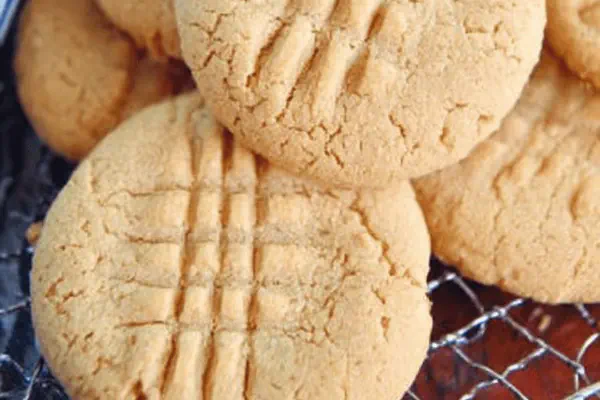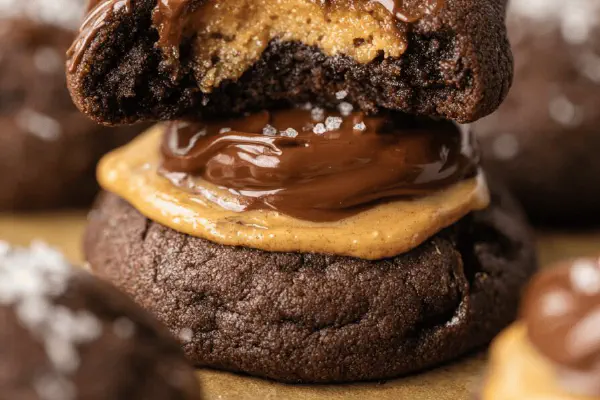Soft Peanut Butter Cookies

By Emma
Certified Culinary Professional
Ingredients
- 1 cup unsalted butter softened
- 3/4 cup packed light brown sugar
- 1/2 cup granulated sugar
- 1 cup peanut butter creamy or chunky
- 2 tsp almond extract substitute vanilla extract
- 2 large egg yolks prefer over whole eggs for chew
- 1/4 cup whole milk substitute sour cream or yogurt
- 1 tsp baking powder reduced from 1 1/4 tsp
- 1/4 tsp baking soda reduced slightly
- 1/2 tsp salt
- 2 1/4 cups all-purpose flour
- granulated sugar for rolling
About the ingredients
Method
- Combine softened butter, brown sugar, and granulated sugar in a large bowl or stand mixer bowl fitted with paddle. Beat on medium speed until pale and creamy about 1 1/2 minutes. You want sugar fairly dissolved into butter for tender crumb.
- Add peanut butter. Mix until integrated but not overbeaten. You want streaks of peanut, not oil separated.
- Mix in almond extract, then add egg yolks one at a time, mixing well after each addition. Egg yolks contribute fat and chewiness; whites can dry cookies out.
- Mix in milk or sour cream. This adds moisture and slight tang balancing peanut butter sweetness.
- In separate bowl sift together flour, baking powder, baking soda, and salt. Mixing powder and soda with flour first ensures even rise and avoids pockets of leavener.
- Add dry ingredients to wet mixture gradually. Mix with paddle just until the dough comes together. Overmixing brings gluten, toughens cookies.
- Cover dough and chill for 45 minutes to 1 hour. Chilling firms dough for easier shaping and helps control spread in oven.
- Preheat oven to 350°F (175°C). Line baking sheets with parchment or silicone mat for even, no-stick baking.
- Scoop dough into 1-inch balls using cookie scoop or spoon. Roll gently in granulated sugar until coated. The sugar creates crackly texture on outside.
- Arrange balls spaced 2 1/2 inches apart. Give room to spread without fusing.
- Flatten each ball with fork dipped in sugar (keeps fork from sticking) to create crisscross pattern. Don’t press too thin or cookies dry out.
- Bake 10 to 14 minutes. Watch edges; dough will look set but still soft in middle. Underbaked cookies can look a bit glossy centers. Remove once edges get faint golden – document shows signs, not only timer.
- Cool on baking sheet 3 minutes; cookies set further and handle better when moved. Then transfer to wire rack to finish cooling. Too hot cookies won’t cut cleanly or store well.
- Store in airtight container at room temp max 4 days. For longer storage freeze shaped balls before baking or freeze baked cookies.
- Try swapping creamy peanut butter for chunky to add texture contrast. If dough too soft when chilled, add a bit more flour by tablespoons.
- If cookies spread too much, next time chill dough longer or reduce butter by 1 tbsp. Weather affects how much spread you get so watch closely mid-bake.
- Too dry? Add an extra egg yolk or a tbsp milk next run.
Cooking tips
Chef's notes
- 💡 Butter soft but not melting. If butter melts, dough gets greasy and tough to handle. Brown sugar packs moisture, chew. Light brown fine, dark brown adds molasses depth but watch liquids. Peanut butter creamy holds moisture, chunky adds texture but dries faster baking. Almond extract stronger than vanilla, add slow; can overpower fast. Egg yolks hold fat, add chew; whites dry hands. Milk adds moisture, tang when replaced with yogurt or sour cream. Adjust baking powder for acidity shifts from substitutes.
- 💡 Mix sugars with butter until pale, creamy. Not just blended but sugar dissolving a little in butter. This step aerates; skip or rush and cookies flatten in oven, lose softness and rise. Add peanut butter next but don’t overbeat or oil separates; some streaks fine. Almond extract goes in before egg yolks blend flavor evenly. Egg yolks one at a time. Whites discarded or saved for omelet. Milk or substitutes last to balance moisture after eggs.
- 💡 Dry mix sifted separate. Flour, baking powder, baking soda, salt combined. Keeps leaveners dispersed. Add dry ingredients slowly into wet. Mix just to combine. Overmix wrecks gluten; cookies tough and flat. Dough should hold but not rubbery. Cover and chill minimum 45 minutes. Chilling firms dough, controls spread in oven. If dough soft, sprinkle flour tablespoon increments. Dough elasticity key; too soft, cookies blob and lose shape.
- 💡 Roll dough into balls 1-inch, coat in granulated sugar before baking—adds sparkle and crackly crunch. Fork dipped in sugar pressed crisscross on each ball prevents fork sticking; don’t press too thin or cookies dry out. Space balls at least 2 1/2 inches apart for spreading. Watch closely between 10 and 14 minutes. Edges firm but cookies remain pale in center indicates done. Underbaked cookies center glossy, not set. Baking time varies; oven heats uneven, trust eyes over clock.
- 💡 Cool cookies on baking sheet 3 minutes after removing from oven. This finishes cooking gently, prevents cracking. Then move to wire rack. Hot cookies soft, difficult to handle. Store airtight at room temp max 4 days. For longer stash, freeze dough balls before baking or finished cookies. If cookies spread too much, chill dough longer next time or cut butter by a tablespoon. Weather affects spread; humid warm kitchens loosen dough, cooler dry firm dough. Too dry? Add extra egg yolk or tablespoon milk next batch.
Common questions
Why swap egg yolks for whole eggs?
Yolks add fat, increase chewiness. Whites dry out dough, can make cookies crumbly or brittle. Tried both, yolks gave richer texture. Avoid using whites here or cookies dry fast and crack.
Can I replace almond extract?
Vanilla can. Almond stronger, sharper. Use less vanilla to start or you lose subtle nuttiness. Lemon or coconut extract doesn’t fit flavor profile; changes cookie too much. Experiment small batches if swapping.
What to do if dough too sticky after chilling?
Dust with flour tablespoon by tablespoon. Don’t overdo or cookies get tough. Chill longer if possible. Sticky dough spreads too much, hard to shape. Butter temp or peanut butter type can affect stickiness.
How long keep cookies fresh?
Room temp airtight max four days. After that, cookies harden and lose chew. Freeze dough scoops for quick bake later or bake then freeze cookies in airtight bag. Thaw at room temp; reheating in microwave few seconds helps soften again.



